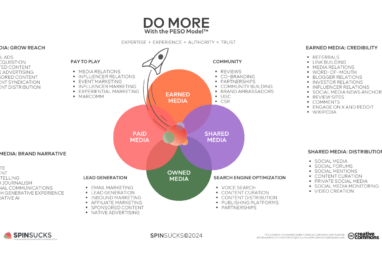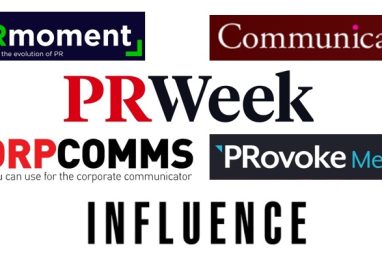Shoot the messenger
When you shouldn’t use your CEO as your lead spokesperson
About the author
Charlie King is a public relations strategist with experience in politics, international development and the NHS. He studied the CIPR PR Professional Diploma with PR Academy and this article was written for one of the assignments.

While the culture varies from organisation to organisation, many communications professionals find themselves under pressure to secure high-profile interview slots for their CEOs and other senior executives. But, in an era of mistrust and misinformation and a media landscape that is unrecognisable from a decade ago, we need a rethink. Should we be using more frontline staff as spokespeople, and what are the benefits and risks?
“Can we have someone other than your CEO?” asked a BBC radio producer when I was setting up an interview a couple of years ago. “They are always media-trained within an inch of their lives, and often don’t really know the details of what they’re talking about.”

It wasn’t the first time I’d had similar feedback. At the time, I was working in a third sector organisation where it was assumed that the pick of the media opportunities would go to the chief executive. It was a difficult pressure to resist.
But the conversation with my BBC contact gave me a good pretext to call this into question.
Having now moved to the public sector, specifically the NHS, I am regularly seeing the benefits of putting forward frontline, relatively junior staff for interviews.
It’s made me wonder: do we, as communications professionals in the public and third sector, think carefully enough about the pros and cons of the spokespeople we use? Could more evidence-based discussion of this subject help us make strategic decisions, as opposed to either crumbling to pressure from the top floor, or simply grabbing the consultant surgeon who is first in your speed dial?
We know what makes a good spokesperson, but do we know who?
Let’s start with first principles. In Strategic Planning for Public Relations, Ronald Smith identifies “credibility, charisma and control” as the three key characteristics you should look for in spokespeople. Logical enough, and not many PR people would argue with these simple qualities for whoever you put up to face Emma Barnett. But in my experience, there’s often a false assumption that your most credible, charismatic and controlled staff are the most senior ones. While Smith does advocate mixing it up beyond your CEO, his assumption remains that it’ll be someone pretty high up the pecking order.
My issue isn’t with the basic principles of what makes a good spokesperson, so much as our assumptions about who embodies those characteristics. What’s to say that only senior staff can be credible and charismatic? I’ve worked with frontline aid workers and midwives who personify those qualities.
Indeed, Smith and other scholars also emphasise a further characteristic that it seems to me that many PR practitioners don’t consider enough: relatability, or what Richard Perloff calls ‘social attractiveness’. In his research on persuasion, Perloff cites social attractiveness – essentially likeability and similarity – alongside authority and credibility as key features.
Similarly, Sabine Einwiller, Daniel Laufer and Christophe Ruppel have shown the benefits of a CEO spokesperson sharing a “common in-group status” with their audience, at least in crisis situations (which, interestingly, are the focus of most of the research on spokesperson selection). It’s context and audience specific, of course, but it’s a safe assumption that staff further down the organogram are more likely to fit this bill.
Can I trust you anyway?
The tumultuous climate we live in currently is further eroding traditional assumptions. Edelman found in its 2018 Trust Barometer that CEOs were ranked behind technical experts (the most trusted), academic experts (second), a “person like yourself” (third) and a regular employee (fifth) as spokespeople – though CEO credibility had recovered a little from an all-time low in 2017.
Indeed, across the board in the 2017 study, regular employees were ranked as more trustworthy than their ultimate boss. Ipsos Mori research puts a finer point on it: the most trusted professions in the UK are nurses, doctors and teachers. Nearly three times as many people would generally trust a nurse than a business leader.
Spokesperson choice reflects the changing nature of PR
In public relations, this atmosphere of mistrust has been accompanied by a democratisation and stratification of the media. Any modern practitioner understands that the media and social media landscape today is such that audiences expect to be able to engage with, discuss and debate messages they are receiving from organisations on equal terms. Hearing from a spokesperson who sounds, potentially looks and even ‘feels’ more like a peer can facilitate this positive process, though also requires the organisation to cede a degree of control.
In this respect, spokesperson choice is more than a short-term tactical decision; it speaks fundamentally to how an organisation approaches its relationship with its audiences. Does it, as with traditional public relations, simply wish to broadcast a message in as unadulterated fashion as possible? Or is it prepared to open a discussion which is, in James Grunig’s words, “two-way and interactive, symmetrical or dialogical, and socially responsible.” And which of an organisation’s staff base is best positioned to facilitate that type of discussion?
What does this mean in practice?
So here goes the theory. Relatability is at least as important as the ‘traditional’ spokesperson qualities such as credibility, which are not the preserve of senior staff. This is becoming more and more the case as trust in authority disintegrates. And as social media has driven PR to become more two-way, spokesperson choice needs to reflect this.
But what does this mean in practice, particularly for the public and charity sectors? Do I advocate never putting your CEO on TV again? Should you put a junior nurse on the Today programme when patient care has gone wrong? The answer to these questions is, of course, no, and the truth more nuanced. My argument is that we should make fewer assumptions and think more carefully about when and how using more frontline staff may be beneficial. What follows is an attempt at some practical guidance to the pros, cons, risks and benefits of choosing different spokespeople in different situations.
Crises and issues management
Much of the theory on spokesperson choice centres on crisis management. Most communications professionals would subscribe to the principle that a serious crisis merits a serious response, and that deploying the CEO or very senior executives sends an important signal that the situation is being actively handled by the organisation’s top brass. There’s clearly merit in this logic. Alan Hilburg, the chief executive of crisis management firm Hilburg Malan, has argued that where fundamental questions have arisen about trust, integrity and organisational values, it’s probably safest to use the most senior staff.
But there are both practical and social scientific arguments against always using the CEO in a crisis. Practically speaking, there are considerations around time commitments and availability. If the CEO is actively engaged in managing the situation, should they, and critically, should they be seen to have time to do a broadcast round?
Secondly, deploying the CEO too readily could be counterproductive if the crisis isn’t severe. A major incident at a hospital is a serious situation, but if there’s no suggestion of wrongdoing by the hospital, could the appearance of the CEO imply that there are concerns about the ability of operational staff to handle the situation?
The identity and profile of a crisis spokesperson is also important to consider, as has been explored by Einwiller, Laufer and Ruppel. The more closely a spokesperson resembles an audience, the more they are trustworthy. If a crisis – even a serious one – relates to an organisation’s relationship with a particular group, such as an ethnic minority or particular demographic, the deployment of a spokesperson with a matching profile could be beneficial. For example, could Shropshire and Telford NHS Trust’s “robust response” to investigations into avoidable baby deaths have been better received had its spokespeople been a female maternity service manager, not the chief executive and official spokesman, both male? Reader comments on this Shropshire Star article would suggest so.
That said, such decisions are finely balanced. Cynically putting forward a member of staff of a particular background could easily backfire, and internally, it could be damaging to use a more junior staff member as what could be perceived as a ‘human shield.’
Persuasion and relatability in proactive PR
The same internal pressures operate in reverse for proactive, positive media stories, where senior staff could risk being accused of ‘stealing the glory.’ While not explored in detail here, the internal dynamics of spokesperson choice are critical to consider; giving frontline staff the public credit they deserve is vital. Yet in such positive opportunities, the pressure to bag kudos-laden media slots for senior staff is at its strongest.
Again, context is king. But the purpose of proactive media relations activity is critical. There’s a consensus in the commercial sector that a charismatic, identifiable CEO is a powerful marketing tool (think Steve Jobs, Richard Branson or James Dyson). But in the public and third sectors, the objective is, generally speaking, more about changing opinions and behaviours than about selling a product. Research and evidence from practice suggests that a senior executive might not be best placed to achieve these objectives.
Social psychologist Susan Fiske’s research into social cognition (how people perceive each other) highlights the importance of two key characteristics, warmth and competence. Translating this model into the international development sector, the excellent Aid Attitudes Tracker research project has shown that frontline workers score most highly on these areas.
The theory is borne out elsewhere; when St Mary’s hospital in London featured in the BBC series Hospital, which largely centred on frontline staff rather than executives, patient complaints decreased. Senior executives may be perceived as competent, but they’re arguably less likely to be perceived as warm. And when it comes to the need to persuade people about personal, emotional decisions (as is likely the case in sectors such as healthcare) Richard Perloff highlights that ‘social attractiveness’ (relatability and likeability) is more critical than expertise.
There are risks. Any interview can veer from subject to subject and it’s senior executives who will have a command of the big picture issues the organisation faces. Media training and thorough briefings therefore remain important, though the practicality and cost of media training potentially large numbers of frontline staff is a barrier. That said, thinking back to that BBC producer’s advice, and when it’s clear that personal warmth and charisma are important, PR professionals need to consider the potential advantages of ceding a level of control they are accustomed to. Again, the unscripted nature of recent documentaries such as Hospital, School and 24 Hours in A&E has demonstrated the value of this approach. Such pieces are shifting audience expectations of the tone of organisational communications.
Taken together, it’s again clear that seniority – sometimes a false proxy for authority and credibility – shouldn’t be the driving factor behind spokesperson choice in proactive PR opportunities. Warmth and relatability are just as, and arguably more, important in persuading an audience of how great your service is. In an age of cynicism, audiences welcome a little bit of the unpolished, unscripted and more ‘human’. And, compared to reactive crisis management, there is more room for manoeuvre when you’ve a positive story to tell.
Channels, choices, and ‘views my own’
More flexibility is also granted by the proliferation of channels available to practitioners. Decisions about spokespeople will always be most challenging in earned media spaces where the message is filtered and shaped by a – potentially hostile – journalist. But, mindful of the theories discussed here, there’s surely little excuse to avoid using senior executives in owned channels, where PR professionals are holding the cameras. In a democratised open space where everyone has a voice, there’s little place for seniority.
The flipside to this very positive development is that everyone is an organisational spokesperson (regardless, in reality, of their Twitter bio’s insistence that their views are their own). The direct connection to doctors or researchers that social media offers is invaluable and indeed essential in an era of two-way communications. But a misworded post can wreak havoc and reflect poorly on an employer. If and how organisations seek to control this is a complex discussion, but a clear media and social media policy that all staff should follow is vital to have in place.
Reconsidering the messenger for internal communications is also a worthwhile exercise. Most organisations will have some form of regular communication from the CEO to its staff. There’s a place for that of course. But the same principles outlined here about relatability and warmth arguably apply equally to internal audiences as they do externally.
Horses for courses
As in so much in public relations, seeking to advance hard and fast rules about spokesperson choice is foolhardy. Context is critical. But in both reactive and proactive PR work, it’s clear that there are both theoretical and practical arguments for not always turning to a senior executive as the default option. This is particularly the case given the multiple channels through which PR practitioners can now operate.
In an age of democratised, bilateral communications and eroding trust in authority figures, the relatability of more junior staff might just be a trump card worth playing more often.


